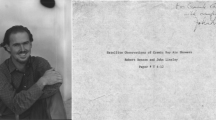Abstract
The Extreme Universe Space Observatory (EUSO) on–board the Japanese Experimental Module (JEM) of the International Space Station aims at the detection of ultra high energy cosmic rays from space. The mission consists of a UV telescope which will detect the fluorescence light emitted by cosmic ray showers in the atmosphere. The mission, currently developed by a large international collaboration, is designed to be launched within this decade. In this article, we present the reconstruction of the energy of the observed events and we also address the X max reconstruction. After discussing the algorithms developed for the energy and X max reconstruction, we present several estimates of the energy resolution, as a function of the incident angle, and energy of the event. Similarly, estimates of the X max resolution for various conditions are presented.

























Similar content being viewed by others
Notes
The Cherenkov reflection will be modelled as a Lambertian reflector with an albedo of 5 %.
A small note should be given on the peaks on GTUs 18 and 20. These peaks are identified given the very unlikely case of peaks of exactly the same amplitude within ± 2 GTUs. The condition chosen for a bin to be accepted as peak is ≥.
A complete explanation on the iteration procedure is out of the scope of this publication. The iteration will be performed by variating the shower parameters obtained through the first reconstruction run. The reconstruction will be applied backward and the detector response obtained in this way will be compared with what originally detected by JEM–EUSO. The deviation of this test from the data will define a confidence interval in the parameter space and possibly deliver a better set of parameters than what was found in the first run.
According to the standard theory the Cherenkov yield is equal to \(C_{\mathrm {Y}}(E,h) = 2 \pi \alpha \left (2 \delta - \left (\frac {m_{\mathrm {e}} c^{2}}{E}\right )^{2}\right )\left (\frac {1}{\lambda _{\min }}-\frac {1}{\lambda _{\max }}\right )\) where α is the fine structure constant, δ is n-1 (n is the refractive index), E the electron’s energy, λ min and λ max are the integration extremes.
The backscattered component is therefore not distinguishable from fluorescence and has to be corrected.
References
Takahashi, Y., et al.: The JEM–EUSO mission. New J. Phys. 11, 065009 (2009)
J. Adams et al. for the JEM–EUSO collaboration: Ultra High Energy Cosmic Rays studies with the JEM–EUSO mission, Experimental Astronomy Journal, this Issue’s number 2 contribution
G.A. Medina Tanco for the JEM–EUSO collaboration: The JEM–EUSO Science capabilities. In: Proceeding of the Int. Cosmic Ray Conference (Rio De Janeiro), ID 0956 (2013)
T. Ebisuzaki et al. for the JEM–EUSO collaboration: The JEM–EUSO mission. Adv. Space Res. 53, 1499–1505 (2014)
A. Santangelo for the JEM–EUSO collaboration: Status of the JEM–EUSO mission. In: Proceeding of the Int. Cosmic Ray Conference (Rio De Janeiro), ID 0956 (2013)
F. Kajino for the JEM–EUSO collaboration: The JEM–EUSO instruments. In: Proceeding of the Int. Cosmic Ray Conference (Rio De Janeiro), ID 1216 (2013)
Casolino, M., Kajino, F.: An overview of the JEM–EUSO instrument, this Issue’s number 8 contribution
Dagoret, S., Barrillon, P., Jung, A., Ebersoldt, A.: The Photodetector Module of the JEM–EUSO mission, this Issue’s number 9 contribution
The JEM–EUSO collaboration: Report on the phase A study 2010. Collaboration Mission Report (2010)
Berat, C., et al.: ESAF: Full simulation of space–based extensive air showers detectors. Astrop. Phys. 33 (4), 221–247 (2010)
Bertaina, M., et al.: Performance and air-shower reconstruction techniques for the JEM–EUSO mission. Adv. Space Res. 53 (10), 1515–1535
The JEM–EUSO collaboration: An evaluation of the exposure in nadir observation of the JEM–EUSO mission. Astroparticle Phys. 44, 76–90 (2013)
Guzman, A., et al.: The peak and window searching technique for the EUSO simulation and analysis framework: Impact on the angular reconstruction of EAS. J. Phys. Conf. Series 409, 012104 (2013)
Mernik, T., Guzman, A., Biktemerova, S.: Performances of JEM–EUSO: angular reconstruction, this Issue’s number 10 contribution
Gora, D., et al.: Universal lateral distribution of energy deposit in air showers and its application to shower reconstruction. Astrop. Phys. 24, 484–494 (2006)
National Oceanic Atmospheric Administration et al.: U.S standard atmosphere, 1976, public document (1976)
Giller, M., et al.: Energy spectra of electrons in the extensive air showers of ultra-high energy. J. Phys. G: Nucl. Part. Phys. V (30), P97–105 (2004)
Air Force Geophysics Laboratory, Users guide to LOWTRAN 7, public document (1988)
Nagano, M.: New measurement on photon yields from air and the application to the energy estimation of primary cosmic rays. arXiv:astro--ph/0406474v2 (2004)
Unger, M., et al.: Reconstruction of longitudinal profiles of ultra-high energy cosmic ray showers from fluorescence and Cherenkov light measurements. Nucl. Instr. Met. Phys. Res. A, 588 (2008)
Naumov, D.: SLAST, shower light attenuated to the space telescope. EUSO mission internal document (2003)
Rossi, B.: Cosmic–ray theory. K. Greisen Rev. Mod. Phys. 13, 240 (1941)
Ilina, N.P., et al.: Sov. J. Nucl. Phys. 55, 1540 (1992)
Kalmykov, N.N., Ostapchenko, S.S.: Sov. J. Nucl. Phys. 50, 315 (1989)
Fenu, F.: A simulation study of the JEM–EUSO mission for the detection of ultra–high energy Cosmic Rays, Doctoral Thesis (2013)
Acknowledgments
We wish to thank the RIKEN Integrated Cluster of Clusters facility for the computer resources used for the calculations. We wish to thank the IPA program of RIKEN (Japan) for its support. This work has been partially supported by the Italian Ministry of Foreign Affairs, General Direction for the Cultural Promotion and Cooperation. We also wish to thank the original ESAF developers for their work.
Author information
Authors and Affiliations
Consortia
Corresponding author
Additional information
The full author list and affiliations are given at the end of the paper.
Rights and permissions
About this article
Cite this article
The JEM-EUSO Collaboration., Adams, J.H., Ahmad, S. et al. Performances of JEM–EUSO: energy and X max reconstruction. Exp Astron 40, 183–214 (2015). https://doi.org/10.1007/s10686-014-9427-9
Received:
Accepted:
Published:
Issue Date:
DOI: https://doi.org/10.1007/s10686-014-9427-9




